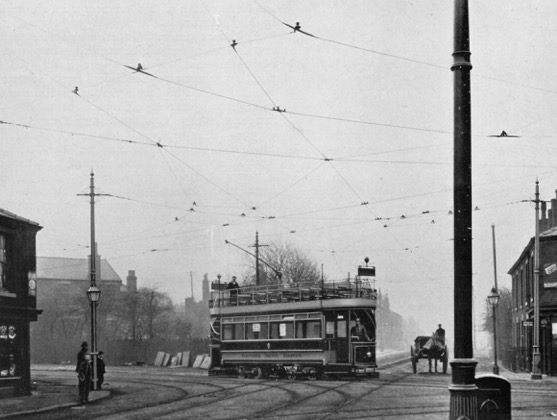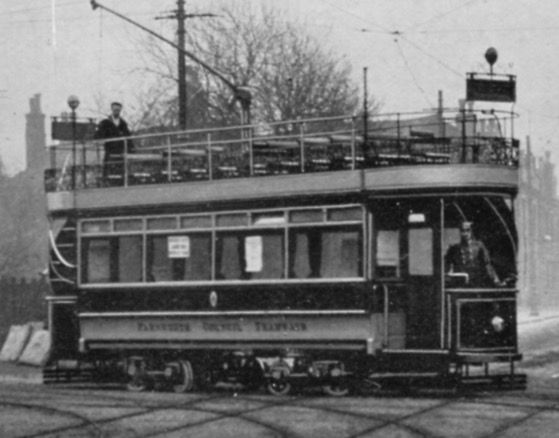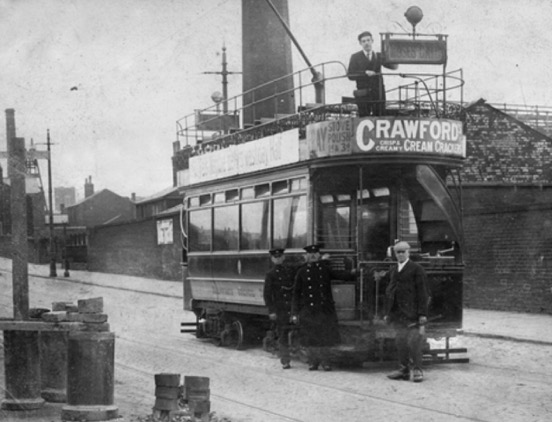Farnworth Council Tramways
History
Although Farnworth's tramway ownership extended as far back as the 1880s, this was not as an independent concern, but rather as a member of a partnership involving Bolton Corporation, and Astley Bridge and Kearsley Local Boards (later Urban District Councils); this enterprise — Bolton and Suburban Tramways — opened the first line of what became an extensive standard-gauge horse tramway system on the 1st September 1880, operation of which was leased to a local undertaking, Edmund Holden and Company (see link). The section owned by Farnworth rans southwards from Moses Gate, along Bolton Road and Market Street to the Black Horse Inn. The line was opened on the 3rd June 1881.
Powers to convert the horse tramway to electric traction were obtained by Bolton Corporation on the 15th July 1897 under the Bolton Tramways and Improvement Act 1897. Work on reconstructing the line in Farnworth began in December 1899, horse tramway operations on the entire system ceasing on the 1st January 1900. Although Farnworth was served by the new Bolton Corporation Tramways electric services, this was only as far as the boundary at Moses Gate, the line beyond to Black Horse being without any service until the conversion was completed. This turned out to be three-and-a-half months later — the first electric services to Black Horse commencing on the 13th April 1900 — a hiatus which did not go down well with Farnworth UDC.
The relationship between the two authorities was in fact less than harmonious, attempts by Farnworth UDC to interest Bolton Corporation in operating additional lines in Farnworth — either as part of a joint enterprise or by Bolton alone — proving fruitless. Given Bolton's reluctance to expand further into Farnworth, the latter decided, on the 13th December 1899, to apply for powers of its own to build and operate an electric tramway system; these were granted on the 6th August 1900 under the Farnworth Urban District Council Act, 1900. On the same date, Kearsley UDC likewise obtained powers to build a short section of tramway from Black Horse southeastwards to its boundary with Clifton Parish (part of Barton-upon-Irwell Rural District) at Unity Brook; the Kearsley Tramways Order received its Royal Assent under the Tramways Orders Confirmation (No 1) Act, 1900.
Construction of the Farnworth system started on the 13th May 1901, the first electric services commencing eight months later on the 9th January 1902; this was followed — on the 20th February — by the first services within Kearsley (from Black Horse to Spindle Point), the full line, through to Unity Brook opening on the 13th March 1902. The Kearsley UDC system was operated by Farnworth UDC under a 21-year lease.
Farnworth held powers for a wildly optimistic 5.7 miles of tramway, which was far too much for such a small and relatively compact town. The UDC had clearly banked on through traffic from Bolton (via Moses Gate), as well as from a number of lines to the south and southeast that the South Lancashire Tramways Company proposed to build. The uneasy relationship with Bolton Corporation deteriorated yet further when it became clear that the latter would not under any circumstances countenance through running between the two systems, and that when its lease of the Moses Gate to Black Horse line expired on the 1st June 1902, its services would thereafter be terminating at Moses Gate. Farnworth was thus left to run its own lines in isolation, most of which, in the absence of through traffic, made little financial sense. In spite of this, Farnworth's tramway operations did manage to eke out a small profit, though not nearly enough to cover interest and loan repayments, let alone a renewals fund.
The hoped-for connections to the south and southeast were dealt a heavy blow in July 1904 when the South Lancashire Tramways Company, which had over-reached itself financially, entered receivership. Luckily for Farnworth, the SLTCo was rescued from receivership in January 1906 by the newly registered Lancashire United Tramways Limited, Farnworth quickly striking a 21-year lease deal with the SLTCo, which it no doubt hoped would then build the desired connecting lines. The SLTCo took over operation of Farnworth's and Kearsley's tramway services on the 1st April 1906, purchasing Farnworth's thirteen tramcars. Formal agreement with Kearsley UDC was reached a little later on the 12th July 1906.
Meanwhile, the SLTCo set about building the connecting lines, extending 1.1 miles from the Farnworth UDC boundary at Brookhouse to Walkden on the 29th June 1906, and onwards another 7 miles — via Swinton Church and Worsley — to Boothstown, where it connected to the rest of the SLTCo system. This was followed — on the 28th February 1907 — by an extension from the Barton-upon-Irwell boundary at Unity Brook, through Clifton to the Pendlebury boundary at Newtown, where it met the tracks of Salford Corporation Tramways.
Where Farnworth had failed, the SLTCo eventually succeeded, striking through-running agreements covering a number of its lines and those of Bolton Corporation, the latter once again running through from Moses Gate to Black Horse and to Clifton (from the 14th June 1909).
The last new line to open within Farnworth was a roundabout route to Walkden via Little Hulton, services commencing on the 28th August 1913.
The Bolton through services to Clifton were cut back from the 13th December 1913, thereafter only running as far as Black Horse.
A new 21-year lease of the Farnworth system was agreed on the 2nd February 1926, part of which included a commitment to completely relaying the track by 1932. Agreement was also reached between the SLTCo and Kearsley UDC on the 10th August 1926; however, whilst the short sections of Kearsley's system that were essential to operation at Black Horse (a few yards where the municipal boundary ran down the centre of the road) were given a 21-year lease, the rest of the system was only leased for four years. The latter lease was probably due to uncertainty in the SLTCo's mind about the future viability of tramway services to the east of Farnworth, given that the track would soon need renewal.
The SLTCo began through services from Bolton To Walkden (via Moses Gate and Brookhouse) on the 3rd May 1926, Bolton Corporation participating from the 6th December 1926. From the 1st April 1927, however, Bolton Corporation operated most of these services, as well as all services between Moses Gate and Black Horse, the SLTCo gradually stepping away from tramway operation in the area.
On the 10th May 1929, the SLTCo obtained powers — under the South Lancashire Transport Act, 1929 — to abandon its tramways and convert them to trolleybus and/or motorbus operation. The same act also authorised the use of trolleybuses in Farnworth and Kearsley, as well as a change in name to the South Lancashire Transport Company.
A brief Indian Summer arrived on the 1st February 1930 with Salford Corporation Tramways cars running through from Deansgate in Manchester to Black Horse; however, they were to last barely a year before being withdrawn (on the 28th February 1931).
Conversion of the SLTCo's lines to trolleybus operation continued apace, the last tram between Farnworth and Pendlebury — via Unity Brook — running on the 7th June 1931, and the last trams from Farnworth to Walkden, via Little Hulton, running on the 18th August 1931. Although the SLTCo was still responsible for maintenance of the infrastructure within Farnworth, the remaining tram services — from Moses Gate to Black Horse, and from Moses Gate to Walkden (via Brookhouse) — were all now operated solely by Bolton Corporation Tramways.
During the Second World War, the tramway lines within Farnworth became ever-more decrepit, a Ministry of War Transport inspector condemning sections of them on the 3rd October 1944. The last trams were withdrawn on the 12th November 1944.
In 1906, the system comprised 4.47 miles of tramway, 2.66 miles owned by Farnworth UDC, and 1.81 leased from Kearsley UDC. Farnworth-owned mileage was later increased to 3.22 miles by virtue of new SLTCo-constructed tracks. The system was extremely compact, with the principle lines running: southeastwards from Moses Gate (the Bolton municipal boundary) to the Black Horse Inn in Farnworth (the boundary with Kearsley) and onwards to Unity Brook (the boundary with Clifton Parish); southwards from Moses Gate via Albert Road to the boundary at Brookhouse; and southwards from Black Horse along Longcauseway, then southwestwards along Buckley Lane towards Little Hulton, again to the municipal boundary. Farnworth's tracks were connected to those of the BCT at Moses Gate, Kearsley at Black Horse, and to the SLTCo at Brookhouse and Buckley Lane.
Uniforms
Unfortunately, photos taken during the four years that Farnworth operated the system are extremely rare, and those which have survived only show motormen and conductors at a distance. Based on this rather sparse evidence, it would appear that staff wore double-breasted jackets and tensioned-crown peaked caps; the latter bore a small badge of unknown pattern. Crews were also issued with double-breasted greatcoats, which bore metal badges on both collars.
Photographs of inspectors have not survived, so it is not possible to say what style of uniform they wore.
From 1906 to 1944 tramcar staff would have worn the uniforms of the respective operators, i.e., the South Lancashire Tramways Company (see link), Bolton Corporation Tramways (see link), and Salford Corporation Tramways (see link).
Further reading
For a history of the Farnworth and Kearsley UDC's tramways, see: 'The South Lancashire Tramways Company Ltd' by E K Stretch, revised by Ted Gray; Triangle Publishing (2006).
Images
Motormen and conductors
An unidentified Farnworth Council Tramways tram — possibly No 2 — at the junction of Long Causeway and Albert Rd. The photo was probably taken shortly after opening in 1902. Photo courtesy of the Tramways and Light Railway Society, with thanks to David Voice.
An enlargement of the above photograph showing the motorman. The graininess of the photo makes it very difficult to discern details of the uniform jacket, other than that it was double-breasted.
An unidentified FCT tram stands with various tramway staff — photo taken in 1904. The conductor, wearing informal attire and with a cash bag, stands on the top deck. The two uniformed figures are probably motormen, both of whom are wearing double-breasted greatcoats with collar insignia. Their tensioned-crown peaked caps carry a small cap badge.